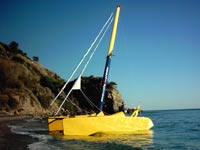 |
our C3200 Catamaran
"Everything is possible..." |
Specifications |
| Hull Length |
- |
800 cm |
Hull Width |
- |
80 cm |
Height Inside |
- |
140 cm |
Total Length |
- |
960 cm |
Beam |
- |
460 cm |
Draft |
- |
80 cm |
Weight (approx) |
- |
850 kg |
Mast Height |
- |
985 cm |
Sail Area |
- |
50 sqm |
Engine |
- |
15 hp |
Occupancy |
- |
10 max |
Hello from Andalucia,
We would like to introduce our catamarán C3200
“Everything is possible….”
We have lived in Nerja (Malaga), South Spain for
six years now and the sea is directly on our doorstep.
Of course we had to have a boat. Since building boats
is my profession and I am also a big catamaran-fan
– I started looking for the ideal design. The
following points had to be considered:
- The catamaran had to come out of the water after
every sailing trip because the next harbours (marinas)
are 10 and 15 miles away, and are completely full.
Therefore the catamaran had to have wheels in order
for the Caterpilar to pull it across the beach to
the boat storage.
- It had to be able to be sailed with 1 hand only,
because it would have to be used in the day charter
business in the summer months. So it had to be:
easy, quick and profitable.
- And last but not least: It had to be built on
a very low budget. The time of 4 months for €5.000
- €7.000 was allowed but I can now say that
it has turned out to be €12.000 and a 7-month-building-period
as well as approx. 700 labour hours (6 weeks break
inbetween because of the immense heat in the summertime).
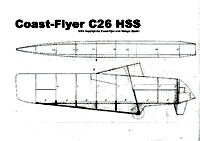 |
The catamaran
had to have wheels in order for the Caterpilar
to pull it across the beach to the boat storage. |
For the design I was inspired by the french-design
Raidrider however the C3200 is an absolute shanty-style
(scharpie) because I didn’t have time for forming
and bending. Also we necessarily needed a center gondola
so we started drawing our catamaran the way we saw
it.
Regarding the rig: it should have had an A-frame
mast angled toward the rear but HSS (Horizontal Sailing
System) was the keyword. Many nights I drew and thought
about it, but as Othmar Karschulin the founder of
www.multihull.de
said: "It will be an experiment because no one
has experience with the rig on an 8 mtr. Catamaran."
I considered James Wharram's Wingsail… but finally
I decided on a completely different system. More about
that later.
On the 23rd of March I started a scaffolding with
square metal tubes. My neighbours declared me mad
saying: "How on earth would that be able to swim?"
The total wood bill, inclucing marine plywood planking
(7 mm), vertical frames (22mm), grounds (10 &
15 mm), came to €1.400 which was quite o.k. .
The next steps were to cut the vertical frames and
keels, glue them and then adjust the frame.
 |
The first hull
was standing. After removing the metal frame
we built with the second hull. |
The first hull was standing. After removing the metal
frame we built with the second hull. Now they could
be connected with the beams. The beams cost me €150.
They came from a 14mtr. mast (200 x 125 mm profile)
off of a Beneteau. The yacht transporter somehow got
caught on a house corner between shipyard and harbour
and since then it had sat in a lonely corner of the
yacht harbour.
Now the decks are being glued…….
Both keels have to be very steady and strong because
the wheels have to be fastened on the ends. For this
I have welded a supporting frame from stainles steal
square pipes which I have glued to the individual
frames. Both sides have been covered with 15 mm Plywood.
The canopies were made from 3 mm plywood and then
laminated over. Both hulls were sanded and coated
with epoxy resin. Afterwards I’ve did the paint
job.
At the same time, I started building the gondola.
The requirements were as following: The outboard engine
had to disappear completely in a box. Apart from that
it has to have mounting points for the wheels to be
able to cart them to our beach 50 mtr further. The
building materials for this: 15 mm and 8 mm plywood.
The equipment rack was really an optical gag, but
it has proven to be very meaningful in actual experience.
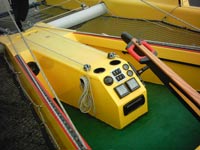 |
The equipment
rack was really an optical gag, but it has proven
to be very meaningful in actual experience.
|
Luckily, I was given a large number of aluminium
tubes for free (case of beer - Actually I only asked
for the front beam). Since a mast profile is not very
cheap, I was obliged to make something out of scrap
aluminium. I had 80 mm and 100 mm pipes with a wall
thickness of 5-6mm. The 100s were too heavy and the
80s too slim. So what could I do? That is when the
aerofoil/wing mast idea came into me and with that
the future sailing system was set. It needed to be
as easy as possible, therefore I will do without a
mainsail and only sail with a jib and a genoa. This
provoked a lot of prejudices because this kind of
rig is not common. But experience proved different.
More about it later. I used an 80 mm pipe as leading
edge, cut ribs for the profile from PU-foam, covered
the whole with 3 mm plywood, laminated twice with
300g fiberglass and finished the wing mast for €200.
Well, the weight wasn’t too good. With a length
of 10 mtr and reduced from 50 cm to 30 cm, it weighed
without spreader 55 kg. But it looks really good.
The 23rd of October was the big day. All parts were
brought to the beach and assembled. The crane was
ordered for 16.00 h to set the mast. Unfortunately
the mast slipped out of the strap because one of the
helpers didn’t watch out, and fell from a height
of 6 meters onto the sand. No real damage, just cosmetic.
I repaired it with tape - then the next shock. The
back stays were 70 cm too long. An error of measurement
on my part… Despite all that we gave the cat
it's name: Everything is possible….
and celebrated with a beach party until early in the
morning.
On Sunday afternoon I wanted to get the boat in the
water, because I desperately wanted to know where
the water line was. It was a strange feeling when
the Caterpilar pushed me into the water backwards.
My worst thought was that the water would swash over
the swim platform, but it's short by 10 cm. After
an overall check, I turned the engine on, pushed the
throttle forwards and we started our first test drive.
Up to that point our catamaran had fulfilled all our
expectations.
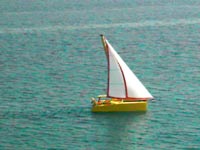 |
The wind was
getting stronger and the Cat was getting faster.
The portside hull was lifting. |
On Monday I had the back stays shortened and repaired
the mast top and on Tuesday it stood as planned with
a 15 degree declination aft. Both sails as well as
the 10 hour old Mercury 15 HP outboard were bought
very cheap on the www.bootsboerse.de
website. The genoa had to be shortened at the lower
leech. Both sails have roller furling gear from Alpa.
The 4 main-sheets as well as the both furler-sheets
are easily being operated from the cockpit with 2
Antal 30 winches.
A few days later we went into the water with the
new rig. With a slight wind it suddenly went backwards!!!
I rolled up the sails, put on the engine and drove
a few miles out, then the wind came up. Engine in
the box, sails out and off it went. The wind was getting
stronger and the Cat was getting faster. The portside
hull was lifting.
The cat was going 4 –6 knots. That is not bad
with 4 wheels on the keels, is it? (obviously they
come off). On the night of Dec 26, 2004 (Tsunami in
Malaysia) we also had a very, very big storm here
on the Costa del Sol and during that night, I lost
both sails and the vessel collided with another boat
in the boatyard!
In the spring the new sails from Stravsails in Slovenia
arrived and we set out for the next test drive. At
about 20 knots of wind, the vessel reached 8-10 knots
speed to windward. Not superfast for this fast looking
design but enough for the cheap sailing system.
A lot of questions have been answered on to the German
Multihull-Forum. I must admit that this is my first
wooden boat - before this I worked only in GRP.
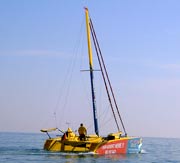 |
In the spring
the new sails from Stravsails in Slovenia arrived
and we set out for the next test drive. At about
20 knots of wind, the vessel reached 8-10 knots
speed to windward. |
For the fillets we used 30 liters of wood flour.
Epoxy we got for €5,80/kilo. Total used: 90 kg.
2K-PU yacht paint was €14/kilo. We esed 20 Kg.
The hulls as well as the gondola were not completely
fiberglassed over - only the stressed points - but
they were given three coats of epoxy resin.
Best wishes from the sunshine Coast
Angelika & Achim
www.coast-flyer.com
coast_flyer@hotmail.com |